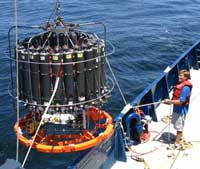|
The Project
 Research Methods Research Methods
 Research Questions Research Questions
The Locations
How to Use This Site
Links
Part 1:
January 25 - February 9, 2005
The Team
Daily Journal
New Horizon Daily Report
New Horizon Cruise Track
Part 2:
July 23 - August 13, 2005
The Team
Daily Journal
New Horizon Daily Report
New Horizon Cruise Track
Part 3:
August 30 - September 8, 2005
The Team
Daily Journal
R/V Wecoma Daily Report
R/V Wecoma Cruise Track
Contact Us

| The Project: Research Methods
The scientists are still learning about these plant cells and how they work as biochemical thermometers. The scientific team has grown the plants in their laboratories. They have analyzed the plant cells that have grown in laboratory conditions. Now, they have the more difficult task of understanding what happens in the ocean. This is difficult because it is hard to take water samples all the time. How can the scientists really know what is going on within a very large body of moving water?
Here’s what they plan to do:

Richard uses a tag line to get the CTD safely on and off the ship |
1. Collect water samples seven times a day
The scientists will collect ocean water samples by using a CTD-rosette. This is an instrument that reads the electrical Conductivity (related to salinity) and Temperature with Depth in the water (calculated from pressure). As the instrument is lowered through the water column, this information is sent from the CTD-rosette back to a computer in the lab on the main deck. This allows the scientists to see these properties in "real-time". The frame housing the CTD also holds a ring (rosette) of "Niskin" water sampling bottles. As the instrument passes through the water, individual bottles can be "closed" by computer, capturing a seawater sample from any specific depth. Once on deck, samples from the Niskin bottles are transferred into clean bottles for chemical analysis. The analysis will measure organic carbon and pigments. Some of the analysis will be done on board the ship, and some will be done back at the lab with a chromatograph.

The process of photosynthesis |
2. Send carboys out to drift freely in the ocean.
(Otherwise known as “Deploying a free-floating array” or “Sending the boys out to loiter with a purpose around the ocean”) Some of the water collected in the early morning (see above) will be drained into carboys. Each carboy, a large transparent container, holds 25 liters of water. This water will still have plants in it. Carbon dioxide containing the element Carbon 13 (C13) as a tracer will be added to each carboy. (Plants use sunlight and carbon dioxide to make organic matter. This is called photosynthesis.)
The carboys, attached to floats, will be thrown over the side of the ship to drift freely for 24 hours. This will give the plants inside the carboys a chance to live in the same ocean conditions (light and temperature) as if they weren’t in the carboys. After the 24 hour period, the carboys will be brought back on deck. The water will be filtered and the plants will be analyzed. The scientists will find out how much C13 appears in the organic matter of the plant. This will tell the scientists how fast the plants are growing in these oceanic conditions.
  
This special report was made possible by NSF Marine Geology and Geophysics Award Nos. OCE-0326573 to Fredrick Prahl (Oregon State University)and OCE-0324299 to Brian N. Popp (University of Hawaii) for study of "Alkenone Production and Productivity in Contrasting Surface Water Environments in the North Pacific Ocean."

|








